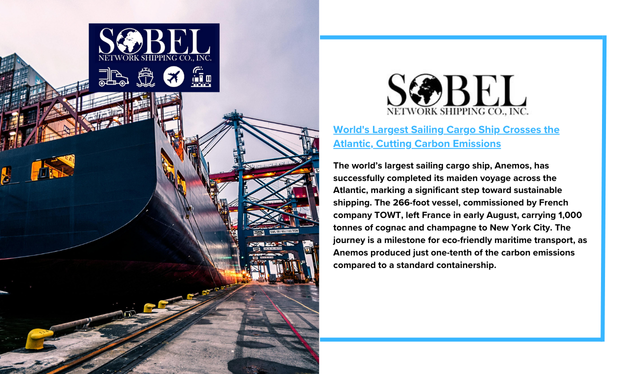The world’s largest sailing cargo ship, Anemos, has successfully completed its maiden voyage across the Atlantic, marking a significant step toward sustainable shipping. The 266-foot vessel, commissioned by French company TOWT, left France in early August, carrying 1,000 tonnes of cognac and champagne to New York City. The journey is a milestone for eco-friendly maritime transport, as Anemos produced just one-tenth of the carbon emissions compared to a standard containership.
Guillaume Le Grand, CEO of TOWT, emphasized the long-standing reliability of wind as a propulsion source for deep-sea travel. “For centuries, we knew wind was abundant over the deep sea,” he said. “But now, thanks to satellite communication and routing technology, wind is also predictable, making it a reliable source of propulsion.”
Anemos is equipped with a state-of-the-art automated system for its cloth sails, which were designed using computer simulations to optimize performance. This enables the ship to transport 1 tonne of cargo over a kilometer while emitting less than 2 grams of carbon dioxide. In contrast, traditional containerships emit at least 20 grams of carbon dioxide per tonne per kilometer.
Although the ship primarily relies on wind power, it is also equipped with two diesel-electric engines as a backup. Anemos is the first in a planned fleet of eight ships, which aim to revolutionize the maritime shipping industry by significantly reducing its carbon footprint.
However, despite these advancements, the overall impact of wind-assisted ships remains difficult to measure. A recent report from Lloyd’s Register, a U.K.-based maritime services company, highlighted uncertainties surrounding actual fuel savings and a lack of standardized criteria for validating those claims. Hidden costs related to engineering and operations may also affect the long-term viability of these vessels.
Nevertheless, Gavin Allwright, Secretary of the International Windship Association, believes the development of sailing cargo ships could help the shipping industry achieve its net-zero emissions targets. As the sector continues to evolve, ships like Anemos represent a promising step forward in the global effort to reduce carbon emissions in shipping.


